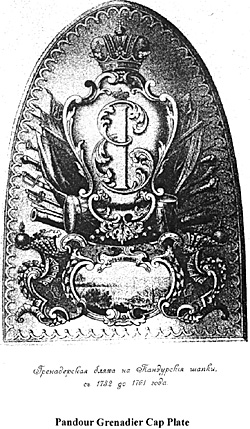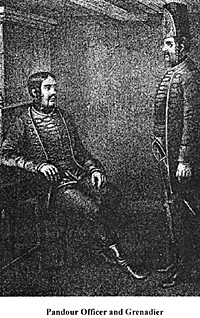
The next period of the Pandour development began in 1741. When the War of 1736-39 with Turkey ended, many volunteers wished to stay in Russia. In the previous chapter I described irregular units raised during this War. Many of them were completed from natives of the countries remaining under Turkish rule.
These men couldn't return home when the hostilities had ended and were allowed to stay in Russia. They were encouraged to enlist into the Russian regular army or settle in the Southern regions of Ukraine. This predetermined the following development of Pandour troops in Russia. Some of them became a part of the regular army; others formed military settlements like the Austrian Grenz military settlements. But both their histories were connected and depended on the struggle between Russia and Turkey in the Ukrainian and Moldavian steppes.
On October 14, 1741 Princess Anna Leopoldovna of Braunschweig- Lunenburg, who ruled Russia from November 11, 1740 to November 25, 1741, authorized the raising of 4 Hussar regiments (each of 10 companies) from natives who had remained in Russia:
- Serbskyi (Serbian)
- Gruzinskyi (Georgian)
- Vengerskyi (Hungarian)
- Moldavskyi (Moldavian)
The Serbian Hussar Regiment was formed on the Kommanda of Serbian Hussars and other Serbs, which "in 1740 were numbered about 1,000." The Georgian Hussar Regiment was raised from 3 available companies and extra volunteers.
The Hungarian Hussar Regiment was composed of Hungarian natives who had settlement in the southern regions of Russia, totaling about 500 men by 1741.
The Moldavian Hussar Regiment was raised from Moldavian and Wallachian volunteers who had joined the Russian Army during the 1736-39 War. For the most part they were from Kantemir's Hussar regiment. Viscovatov wrote, that in 1741 total strength of Moldavian Hussars was about 700 men.
These regiments were enlisted, not conscripted. They were on a level between regular and irregular cavalry. Hussars were recruited only from the title nation; i.e. these regiments were national units in Russian service. All troops (including officers) were national and commands were given in the national languages. Each regiment was supposed to have a fixed organization of 10 companies, each of about 100 men. But these regiments were recruited from different sources, and I believe, that they had never achieved authorized strength. Some OB's confirm this.
Some of these regiments took part in the war with Sweden of 1741-43. The List of the Russian field army under Field Marshal Lacy near Vyborg at the end of May 1742 included:
- Detachment of the Horse Guard - 300 men
3 Cuirassier regiments - 1,640 men
6 Dragoon regiments - 4,200
3 Hussar regiments - 1,686
3 battalions of the Guard - about 1,500 men
23 Infantry battalions - each about 500 men
Galley fleet - about 10 000 men on 43 galleys
Total: about 35-36 000 men.
So, you can see that the average strength of the Hussar regiment was about 600 men, instead of the authorized 1000. Unfortunately it is not known what Hussar regiments took part in the campaign against Sweden.
In 1739 Austria lost a war to Turkey, and after the Treaty of Belgrade Serbia fell into Turkish hands. Thousands of Serbs moved to Russia. On December 24, 1751 ex-Colonel of Austrian service Horvat was allowed to establish a separate Serbian settlement in the southern Ukraine. Russian officials intended to use them for protecting the Russian southern border. They planed to settle Serbs along the frontier with the Crimean Tartars and form a sort of Austrian-style Grenz infantry. The Serbs received undeveloped lands on the right side of the Dnepr, between the rivers Kavarlyk and Amelnik, which were won back from the Turks and Crimean Tartars in the last war.
The territory of the Serbian settlements was called Novaia Serbia (New Serbia), with its administrative center in Novomirgorod. This land received the same status as did the Cossack lands: New Serbia had an administrative autonomy, Serbs preserved their customs and traditions; they had their own legal proceedings and military organization.
The Serbs were organized after the Austrian Grenz infantry, and because of their Balkan roots they were all called Pandours in Russia. All of the male population was registered and had to serve in the case of hostilities. All men available for service were divided into two parts: active and reserve. The former patrolled the frontier and were on garrison duty in the strongholds. The latter worked their plots and had to be present at strongholds with arms and supplies at the first summons.
New Serbia had an administrative division of 20 company districts. Each district provided one hors (Hussar) and one foot (Pandour) company. By the first Ordinance of Dec.24, 1751 the New Serbia military were collected into one Pandour and one Hussar regiment, each of 20 companies. But by January 11, 1752 Horvat was allowed to raise one more Pandour and one Hussar regiment, each of 20 companies also. At the same time the staff of the Pandour regiments was changed. They now consisted of 5 Grenadier and 15 Pandour (Musketeer) companies each. Unfortunately the sources remain silent as to how these changes had an effect on the administrative system. The total number of the New Serbia military establishment was 6-10,000 men (total settlement: 25-30 000).
Following Horvat were other Serbian leaders. On May 17, 1753 Lieutenant Colonels (ex-Austrian) Shevich and Preradovich were allowed to establish Serbian national settlements on the left side of the Dnepr, between the rivers Bahmut and Lagunia on the same conditions as above. This territory was called Slaviano-Serbia (Slavonic Serbia) with its administrative center in Slaviansk.
This settlement was numbered at around 10,000 by the end of 1753. In contrast to New Serbia, the Slavonic Serbia military establishment consisted only of horse. On March 31, 1754 Shevich and Preradovich were allowed to raise 2 Hussar regiments, each of 20 companies, named after colonels (Shevich and Preradovich).
 All of these Serbian units (4 Hussar and 2 Pandour regiments) were from the
military settlements. The practice of using settlement units for protecting the
southern border had been implemented by the Russian government since the
middle of the 17th Century. In the 1650's they were Ukrainians, but by the
1750's the Ukraine had become a part of the Russian State, and the settlement
units had become Serbian. Every Hussar or Pandour received an individual plot
of land and some money for initial expenses. They had to buy their own
equipment, horses and weapons with their own funds.
All of these Serbian units (4 Hussar and 2 Pandour regiments) were from the
military settlements. The practice of using settlement units for protecting the
southern border had been implemented by the Russian government since the
middle of the 17th Century. In the 1650's they were Ukrainians, but by the
1750's the Ukraine had become a part of the Russian State, and the settlement
units had become Serbian. Every Hussar or Pandour received an individual plot
of land and some money for initial expenses. They had to buy their own
equipment, horses and weapons with their own funds.
In peacetime these men were in turn on guard duty near their settlements. During wartime they joined the field army. During their service these troops received payment from the state, in other times they lived off their plots of land. As a Russian historian wrote, the main defect of the Serbian settlement troops was that "they were numerous only when they received money." At the same time they were of high military value, because the constant Tartar raids had shaped them into a solid fighting force that could be assembled quickly and to great effect.
In 1756 Russia entered into the Seven Years War. The first actions demonstrated a lack of regular light cavalry. The Russian army had numerous Cossacks and Tartars, but they were irregulars and couldn't fight in lines. The only regular light cavalry were 4 field Hussar regiments, but it was a drop in the bucket compared to the heavy regiments. The Russian officials tried to change the situation by the enlistment of local natives into the Hussars. This mission was charged to General Horvat.
On May 10, 1759 he enlisted 2 field Hussar regiments:
- Macedonian,
- Bulgarian
Each consisted of 10 companies. On December 11, 1760 one more Hussar regiment, called Zeltiy (Yellow), was added. It was formed from Serbs settlement in New Serbia who had volunteered.
The Macedonian and Bulgarian Hussars didn't amount the staff strength and took no part in the Seven Years War actions. At the same time the exigency of the regular light cavalry resulted in the sending off the settlement Hussar regiments. Duffy writes (Christopher Duffy, Russia's Military Way to the West. Origins and Nature of Russian Military Power 1700-1800, Otley (West Yorkshire), Terence Wise, 1994), that in the following Hussar regiments took part in the Seven Years War:
- Serbian,
- Hungarian,
- Georgian,
- Moldavian,
- Horvat,
- Slavonic Serbia,
- Yellow,
- New Serbia.
Konstant gives (Angus Konstam, Russian Army of the Seven Years War, 2 vols., London, Osprey, 1996) different information:
- Serbian,
- Hungarian,
- Georgian,
- Moldavian,
- 1st Novoserbian,
- 1st Slavianoserbski
I believe that Horvat and 1st Novoserbian are the same unit. The regiment named after colonel Horvat was the oldest unit formed in New Serbia, and it is possible that some sources identified it as the 1st regiment of the New Serbia settlement. Another situation with the Slavonic Serbia military is that it included only 2 Hussar regiments, without any Pandour troops and sending off a full settlement regiment would expose a sector of the frontier. So, I believe that the Russian officials formed a combined Hussar regiment, called Slavonic Serbian. Otherwise, it would be called after its colonel (Shevich or Preradovich).
The departure of the military forces from the southern border to Prussia demanded the strengthening of the rest troops. On June 13, 1759 the Novomirgorod garrison was formed as separate unit. It consisted of 1 Grenadier and 3 Pandour companies. Sometimes it is referred to as the Third Pandour regiment, but I think this is incorrect. It had the staff organization similar to that of a battalion of the Russian garrison infantry, and it is better to call it garrison battalion.
So, by December of 1761, when Peter the Third ascended the Russian throne and ended hostilities with Prussia, the following Slavic (non-Russian) units were in the official List of the Russian Army: Hussar Regiments - 8 (each of 10 companies):
- Serbian,
- Georgian,
- Moldavian,
- Hungarian,
- Slobodian,
- Macedonian,
- Bulgarian,
- Yellow.
Settlement Hussar Regiments - 4 (each of 20 companies):
- Horvat,
- Novoserbian (New Serbian),
- Shevich,
- Preradovich.
Settlement Pandour regiments - 2 (each of 5 Grenadier and 15 Pandour companies) and the Novomirgorod Garrison (battalion of 1 Grenadier and 3 Pandour companies).
Footnotes:
The Slobodian Hussar Regiment was formed on September 26, 1756 from ex-Slobodian Cossacks, and was officially related to the Pandour Hussars. I have not found reference to any names for the infantry Pandour regiments. Probably they were just called the 1st and 2nd.
More Russian Pandours
- Introduction: The First Pandours in Russian service (1707-41)
Pandour Hussars (1741-61)
Regular Hussars (1763-83)
Uniform of the Padours 1741-1763
Back to Seven Years War Asso. Journal Vol. XII No. 1 Table of Contents
Back to Seven Years War Asso. Journal List of Issues
Back to Master Magazine List
© Copyright 2001 by James J. Mitchell
This article appears in MagWeb (Magazine Web) on the Internet World Wide Web.
Other military history articles and gaming articles are available at http://www.magweb.com